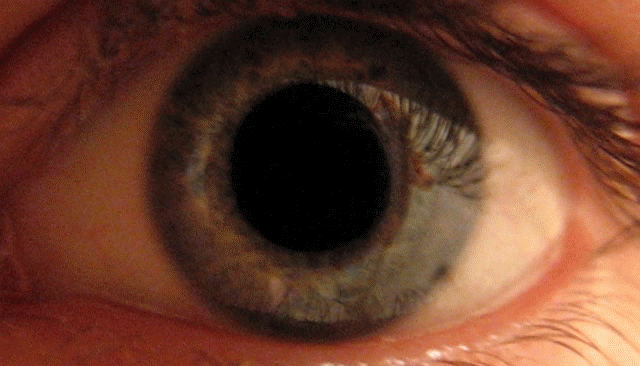
Pupillary response
Encyclopedia

Pupil
The pupil is a hole located in the center of the iris of the eye that allows light to enter the retina. It appears black because most of the light entering the pupil is absorbed by the tissues inside the eye. In humans the pupil is round, but other species, such as some cats, have slit pupils. In...
of the eye via the iris dilator muscle
Iris dilator muscle
The iris dilator muscle , is a smooth muscle of the eye, running radially in the iris and therefore fit as a dilator. It has its origin from the anterior epithelium. It is innervated by the sympathetic system, which acts by releasing noradrenaline, which acts on α1-receptors...
. The response can have a variety of causes, from an involuntary reflex reaction
Pupillary reflex
The pupillary light reflex is a reflex that controls the diameter of the pupil, in response to the intensity of light that falls on the retina of the eye, thereby assisting in adaptation to various levels of darkness and light, in addition to retinal sensitivity...
to inexposure to light — in low light conditions a dilated pupil lets more light into the eye — or it may indicate interest in the subject of attention or indicate sexual stimulation
Sexual arousal
Sexual arousal, or sexual excitement, is the arousal of sexual desire, during or in anticipation of sexual activity. Things that precipitate human sexual arousal are called erotic stimuli, or colloquially known as turn-ons. There are many potential stimuli, both physical or mental, which can cause...
. The pupils contract immediately before someone falls asleep. A pupillary response can be intentionally conditioned
Classical conditioning
Classical conditioning is a form of conditioning that was first demonstrated by Ivan Pavlov...
as a Pavlovian Pavlov's Dog
Pavlov's Dog
Pavlov's Dog is a 1970s progressive rock/AOR band formed in St. Louis, Missouri in 1972. Pavlov's Dog originally comprised David Surkamp, Mark Gahr on lead guitar, Mike Safron, Rick Stockton, David Hamilton, Doug Rayburn, and Siegfried Carver . Mark Gahr left the band and was replaced by Steve...
response to some stimuli.
The latency of pupillary response (the time in which it takes to occur) increases with age. Use of central nervous system
Central nervous system
The central nervous system is the part of the nervous system that integrates the information that it receives from, and coordinates the activity of, all parts of the bodies of bilaterian animals—that is, all multicellular animals except sponges and radially symmetric animals such as jellyfish...
stimulant
Stimulant
Stimulants are psychoactive drugs which induce temporary improvements in either mental or physical function or both. Examples of these kinds of effects may include enhanced alertness, wakefulness, and locomotion, among others...
drugs and some hallucinogenic drugs can cause dilation of the pupil.
In ophthalmology
Ophthalmology
Ophthalmology is the branch of medicine that deals with the anatomy, physiology and diseases of the eye. An ophthalmologist is a specialist in medical and surgical eye problems...
, intensive studies of pupillary response are conducted via videopupillometry.

See also
- Dilated fundus examinationDilated fundus examinationDilated fundus examination is a diagnostic procedure that employs the use of mydriatic eye drops to dilate or enlarge the pupil in order to obtain a better view of the fundus of the eye. Once the pupil is dilated, examiners often use specialized equipment such as an ophthalmoscope or fundus...
- Iris dilator muscleIris dilator muscleThe iris dilator muscle , is a smooth muscle of the eye, running radially in the iris and therefore fit as a dilator. It has its origin from the anterior epithelium. It is innervated by the sympathetic system, which acts by releasing noradrenaline, which acts on α1-receptors...
- Iris sphincter muscleIris sphincter muscleThe iris sphincter muscle is a muscle in the part of the eye called the iris...
- MydriasisMydriasisMydriasis is a dilation of the pupil due to disease, trauma or the use of drugs. Normally, the pupil dilates in the dark and constricts in the light to respectively improve vividity at night and to protect the retina from sunlight damage during the day...
- MiosisMiosisMiosis is the constriction of the pupil of the eye to two millimeters or less...
- Pupillary light reflex
- PupilometerPupilometerPupilometer is the name used for two different devices—one that measures the distance between pupils, and one that measures the pupil's response to visual stimuli.- Pupillary distance measurement :...

